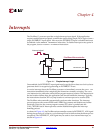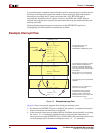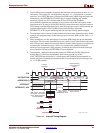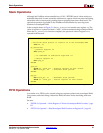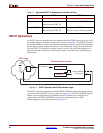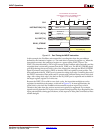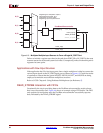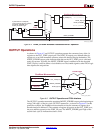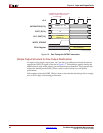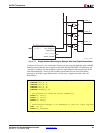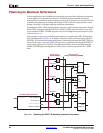
PicoBlaze 8-bit Embedded Microcontroller www.xilinx.com 49
UG129 (v1.1.2) June 24, 2008
R
Chapter 6
Input and Output Ports
The PicoBlaze™ microcontroller supports up to 256 input ports and 256 output ports that
can also be combined to create input/output ports. The interface signals from Figure 2-1
involved in INPUT and OUTPUT operations are described below.
• The PORT_ID[7:0] output port presents the port identifier number or port address for
both INPUT and OUTPUT operations.
• The IN_PORT[7:0] input port captures input data during INPUT operations.
• The OUT_PORT[7:0] output port presents output data during OUTPUT operations.
• The READ_STROBE output is asserted High during the second cycle of the two-cycle
INPUT operation.
• The WRITE_STROBE output is asserted High during the second cycle of the two-cycle
OUTPUT operation.
In timing critical designs, set timing constraints for the PORT_ID and data paths allowing
two clock cycles. Only the read and write strobes need to be constrained to a single clock
cycle. For maximum performance and to simplify timing constraints, insert a pipeline
register where possible, as described in the following sections.
Thought-out design keeps the interface logic compact with good performance. The
following diagrams show circuits suitable for output ports, input ports, and for connecting
memory. When using a logic synthesis tool, check that the source code is not describing a
circuit that is more complex than is actually required and that the synthesis tool is
implementing the intended logic.
PORT_ID Port
The 8-bit PORT_ID port supplies the port identifier or port address for the associated
INPUT or OUTPUT operation. The PORT_ID port is valid for two clock cycles, allowing
sufficient time for any interface decoding logic and for connections to asynchronous RAM.
Similarly, the two-cycle operation allows read operations from synchronous RAM, such as
block RAM.
INPUT and OUTPUT operations support both direct and indirect addressing. The port
address is supplied as either as an 8-bit immediate constant or specified indirectly as the
contents of any of the 16 data registers. Indirect addressing is ideal when accessing a block
of memory, either a peripheral at contiguous port addresses or some form of block or
distributed memory within or external to the FPGA.
Adding external peripherals to the PicoBlaze microcontroller is relatively straightforward.
The only challenge is decoding the PORT_ID value using the minimum required logic for
the application. The decoding challenge depends on the number of input, output, or
bidirectional ports, as described in Table 6-1 and subsequent text.



